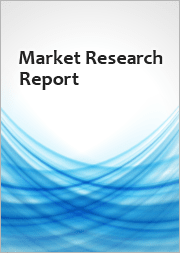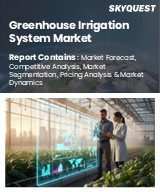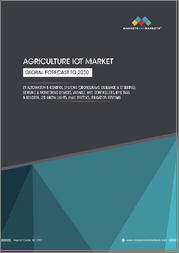
|
시장보고서
상품코드
1570555
세계의 자동 관개 시스템 시장, 기회, 성장 동인, 산업 동향 분석 및 예측(2024-2032년)Automated Irrigation Systems Market, Opportunity, Growth Drivers, Industry Trend Analysis and Forecast, 2024-2032 |
||||||
2023년 자동 관개 시스템 세계 시장 규모는 42억 달러로 평가되었고, 2024-2032년간 연평균 17% 이상의 CAGR을 나타낼 것으로 예상됩니다.
이러한 성장의 주요 원인은 식량 수요 증가와 급증하는 세계 인구를 부양하기 위한 농업 생산성 향상의 필요성에 기인합니다.
기술의 발전, 특히 IoT, 센서 및 클라우드 기반 플랫폼은 자동 관개 시스템의 형태를 바꾸고 있으며, IoT를 통해 농부들은 실시간으로 관개를 모니터링하고 제어할 수 있어 물 사용을 최적화하고 효율성을 향상시킬 수 있습니다. 정교한 센서는 토양 수분, 날씨 및 작물 요구 사항에 대한 정확한 데이터를 제공하여 적시에 관개를 보장합니다. 클라우드 플랫폼은 원격 관리 및 데이터 분석을 가능하게 함으로써 이를 더욱 강화하여 농부들이 정보에 입각한 의사결정을 내리고 생산성을 높일 수 있도록 지원합니다. 이러한 기술은 또한 예측 유지보수 및 다른 스마트 농업 솔루션과의 원활한 통합을 가능하게 하여 시장 성장을 가속하고 매력을 부각시키며, 2024년 6월 TECH-INNOV는 니제르에서 'Wahaless Smart Farming' 이니셔티브 발표했습니다. 이 첨단 시스템은 Tele-Irigation 2.0 도구를 특징으로 하며, 물 사용량 최적화에 중점을 두고 있습니다.
자동 관개 시스템 산업은 자동화 유형, 구성 요소, 관개, 용도 및 지역으로 분류됩니다.
자동화 유형은 시간 기반, 수량 기준, 실시간 피드백, 컴퓨터 기반 제어로 분류되며, 2023년에는 시간 기반 시스템이 34% 이상의 압도적인 시장 점유율을 차지할 것으로 예상되며, 2032년에는 59억 달러 이상에 달할 것으로 예상됩니다. 이러한 우위는 단순성, 비용 효율성 및 사용 편의성에서 기인합니다. 미리 설정된 일정에 따라 작동하는 이 시스템은 소규모 주택 사용자부터 대규모 농지에 이르기까지 다양한 사용자를 대상으로 합니다.
시장은 농지, 온실, 주택, 상업시설, 골프장 등으로 용도를 구분하고 있으며, 2023년에는 농업 분야가 시장 점유율의 약 43%를 차지할 것으로 예상됩니다. 이러한 우위는 대규모 농업에서 효율적인 물 관리의 시급한 필요성에 기인합니다. 자동화 시스템은 물 사용을 최적화할 뿐만 아니라 작물 수확량을 높이고 낭비를 줄일 수 있습니다. 또한, 세계 식량 수요, 물 부족 문제, 지속 가능한 농업을 향한 움직임은 이 부문의 성장을 가속화할 것으로 예상됩니다.
2023년 북미 자동 관개 시스템 시장은 36% 이상의 큰 점유율을 차지할 것으로 예상되며, 2032년에는 62억 달러 이상에 달할 것으로 예측됩니다. 이 지역에서는 선진적인 농법이 강조되고 물 절약 의식과 기술 혁신이 모두 촉진되고 있습니다. 미국은 농업 기술에 대한 막대한 투자와 지속 가능한 관행에 대한 정부의 지원으로 선두를 달리고 있습니다. 물 낭비를 줄이고 농작물 생산성을 향상시키려는 국가적 노력도 시장 확대의 촉매제가 되고 있습니다.
목차
제1장 조사 방법과 조사 범위
제2장 주요 요약
제3장 업계 인사이트
- 생태계 분석
- 공급업체 상황
- 부품 제조업체
- 시스템 통합사업자
- 소프트웨어 개발 기업
- 관개 기기판매 업자
- 설치·메인터넌스 업자
- 이익률 분석
- 기술 및 혁신 전망
- 특허 분석
- 주요 뉴스와 이니셔티브
- 규제 상황
- 영향요인
- 성장 촉진요인
- 업계의 잠재적 리스크&과제
- 성장 가능성 분석
- Porter's Five Forces 분석
- PESTEL 분석
제4장 경쟁 구도
- 서론
- 기업 점유율 분석
- 경쟁 포지셔닝 매트릭스
- 전략 전망 매트릭스
제5장 시장 추산·예측 : 자동화 유형별, 2021년-2032년
- 주요 동향
- 시간 기반
- 볼륨 기반
- 실시간 피드백
- 컴퓨터 기반 제어
제6장 시장 추산·예측 : 컴포넌트별, 2021년-2032년
- 주요 동향
- 컨트롤러
- 스마트 컨트롤러
- 프로그래머블 컨트롤러
- 기후 기반 컨트롤러
- 토양 수분 기반 컨트롤러
- 센서
- 토양 수분 센서
- 비 센서
- 온도 센서
- 기상 센서
- 밸브
- 전동 밸브
- 수동 밸브
- 전자 밸브
- 스프링클러와 이미터
- 고정 스프링클러
- 로터리 스프링클러
- 마이크로 스프링클러
- 점적 이미터
- 펌프
- 기타
제7장 시장 추산·예측 : 관개별, 2021-2032년
- 주요 동향
- 스프링클러 관개
- 점적 관개
- 표면 관개
- 지하 관개
제8장 시장 추산·예측 : 용도별, 2021년-2032년
- 주요 동향
- 농지
- 온실
- 주택
- 상업시설
- 골프장
- 기타
제9장 시장 추산·예측 : 지역별, 2021년-2032년
- 주요 동향
- 북미
- 미국
- 캐나다
- 유럽
- 영국
- 독일
- 프랑스
- 스페인
- 이탈리아
- 러시아
- 북유럽
- 기타 유럽
- 아시아태평양
- 중국
- 인도
- 일본
- 한국
- 뉴질랜드
- 동남아시아
- 기타 아시아태평양
- 라틴아메리카
- 브라질
- 멕시코
- 아르헨티나
- 기타 라틴아메리카
- 중동 및 아프리카
- 아랍에미리트(UAE)
- 남아프리카공화국
- 사우디아라비아
- 기타 중동 및 아프리카
제10장 기업 개요
- Calsense
- Galcon Ltd.
- Hunter Industries
- Hydropoint Data Systems, Inc.
- Hydro-Rain
- Irritec S.p.A.
- Jain Irrigation Systems Ltd.
- Lindsay Corporation
- Mottech Water Solutions Ltd.
- Nelson Irrigation Corporation
- Netafim Ltd.
- Orbit Irrigation Products, Inc.
- Rain Bird Corporation
- Rain Machine
- Raindrip, Inc.
- Rivulis Irrigation Ltd.
- The Toro Company
- T-L Irrigation Co.
- Valmont Industries, Inc.
- Weathermatic
The Global Automated Irrigation Systems Market, in 2023, was valued at USD 4.2 billion with projections indicating a CAGR of over 17% from 2024 to 2032. The growth is primarily driven by the rising demand for food and the need for heightened agricultural productivity to support a burgeoning global population.
Technological advancements, particularly in IoT, sensors, and cloud-based platforms, are reshaping automated irrigation systems. With IoT, farmers gain real-time oversight and control of their irrigation, leading to optimized water use and heightened efficiency. Sophisticated sensors deliver accurate data on soil moisture, weather, and crop requirements, ensuring timely irrigation. Cloud platforms further enhance this by allowing remote management and data analytics, empowering farmers to make informed decisions and boost productivity. These technologies also enable predictive maintenance and seamless integration with other smart farming solutions, underscoring their appeal and driving market growth. In June 2024, TECH-INNOV made strides in Niger, unveiling its "Wahaless Smart Farming" initiative. This advanced system, featuring the Tele-Irrigation 2.0 tool, emphasizes optimized water usage.
The automated irrigation systems industry is classified into automation type, component, irrigation, application, and region.
The market categorizes automation types into time-based, volume-based, real-time feedback, and computer-based control. In 2023, time-based systems held a dominant market share of over 34%, with projections surpassing USD 5.9 billion by 2032. This dominance stems from their simplicity, cost-effectiveness, and user-friendliness. Operating on pre-set schedules, these systems cater to a diverse audience, spanning from small residential users to expansive agricultural fields.
The market segments applications into agricultural fields, greenhouses, residential, commercial, golf courses, and more. In 2023, agricultural fields commanded approximately 43% of the market share. This dominance is attributed to the pressing need for efficient water management in extensive farming. Automated systems not only optimize water use but also bolster crop yields and curtail wastage. Furthermore, global food demand, water scarcity challenges, and a push towards sustainable farming will amplify the segment growth.
In 2023, North America automated irrigation systems market held a significant share of over 36%, with forecasts suggesting it will exceed USD 6.2 billion by 2032. The region's emphasis on advanced agricultural practices has fostered both water conservation awareness and technological innovations. The U.S. stands at the forefront, buoyed by hefty investments in agricultural technology and governmental backing for sustainable practices. The nation's commitment to curbing water waste and amplifying crop productivity also serves as a catalyst for market expansion.
Table of Contents
Chapter 1 Methodology and Scope
- 1.1 Research design
- 1.1.1 Research approach
- 1.1.2 Data collection methods
- 1.2 Base estimates and calculations
- 1.2.1 Base year calculation
- 1.2.2 Key trends for market estimates
- 1.3 Forecast model
- 1.4 Primary research and validation
- 1.4.1 Primary sources
- 1.4.2 Data mining sources
- 1.5 Market definitions
Chapter 2 Executive Summary
- 2.1 Industry 360° synopsis, 2021 - 2032
Chapter 3 Industry Insights
- 3.1 Industry ecosystem analysis
- 3.2 Supplier landscape
- 3.2.1 Component manufacturers
- 3.2.2 System integrators
- 3.2.3 Software developers
- 3.2.4 Irrigation equipment distributors
- 3.2.5 Installation and maintenance providers
- 3.3 Profit margin analysis
- 3.4 Technology and innovation landscape
- 3.5 Patent analysis
- 3.6 Key news and initiatives
- 3.7 Regulatory landscape
- 3.8 Impact forces
- 3.8.1 Growth drivers
- 3.8.1.1 Rising food demand and agricultural productivity to feed a rising population
- 3.8.1.2 Increasing water scarcity and conservation practices
- 3.8.1.3 Technological advancements in IoT, sensors and cloud-based platforms
- 3.8.1.4 Growing government support and policies
- 3.8.1.5 Cost-effectiveness of automated irrigation systems
- 3.8.2 Industry pitfalls and challenges
- 3.8.2.1 High initial investment in installing and maintaining these systems
- 3.8.2.2 High power dependency
- 3.8.1 Growth drivers
- 3.9 Growth potential analysis
- 3.10 Porter's analysis
- 3.11 PESTEL analysis
Chapter 4 Competitive Landscape, 2023
- 4.1 Introduction
- 4.2 Company market share analysis
- 4.3 Competitive positioning matrix
- 4.4 Strategic outlook matrix
Chapter 5 Market Estimates and Forecast, By Automation Type, 2021 - 2032 ($Bn)
- 5.1 Key trends
- 5.2 Time-based
- 5.3 Volume-based
- 5.4 Real-time feedback
- 5.5 Computer-based control
Chapter 6 Market Estimates and Forecast, By Component, 2021 - 2032 ($Bn)
- 6.1 Key trends
- 6.2 Controllers
- 6.2.1 Smart controllers
- 6.2.2 Programmable controllers
- 6.2.3 Climate-based controllers
- 6.2.4 Soil moisture-based controllers
- 6.3 Sensors
- 6.3.1 Soil moisture sensors
- 6.3.2 Rain sensors
- 6.3.3 Temperature sensors
- 6.3.4 Weather sensors
- 6.4 Valves
- 6.4.1 Electric valves
- 6.4.2 Manual valves
- 6.4.3 Solenoid valves
- 6.5 Sprinklers and emitters
- 6.5.1 Fixed sprinklers
- 6.5.2 Rotary sprinklers
- 6.5.3 Micro-sprinklers
- 6.5.4 Drip emitters
- 6.6 Pumps
- 6.7 Others
Chapter 7 Market Estimates and Forecast, By Irrigation, 2021 - 2032 ($Bn)
- 7.1 Key trends
- 7.2 Sprinkler irrigation
- 7.3 Drip irrigation
- 7.4 Surface irrigation
- 7.5 Subsurface irrigation
Chapter 8 Market Estimates and Forecast, By Application, 2021 - 2032 ($Bn)
- 8.1 Key trends
- 8.2 Agricultural fields
- 8.3 Greenhouses
- 8.4 Residential
- 8.5 Commercial
- 8.6 Golf courses
- 8.7 Others
Chapter 9 Market Estimates and Forecast, By Region, 2021 - 2032 ($Bn)
- 9.1 Key trends
- 9.2 North America
- 9.2.1 U.S.
- 9.2.2 Canada
- 9.3 Europe
- 9.3.1 UK
- 9.3.2 Germany
- 9.3.3 France
- 9.3.4 Spain
- 9.3.5 Italy
- 9.3.6 Russia
- 9.3.7 Nordics
- 9.3.8 Rest of Europe
- 9.4 Asia Pacific
- 9.4.1 China
- 9.4.2 India
- 9.4.3 Japan
- 9.4.4 South Korea
- 9.4.5 ANZ
- 9.4.6 Southeast Asia
- 9.4.7 Rest of Asia Pacific
- 9.5 Latin America
- 9.5.1 Brazil
- 9.5.2 Mexico
- 9.5.3 Argentina
- 9.5.4 Rest of Latin America
- 9.6 MEA
- 9.6.1 UAE
- 9.6.2 South Africa
- 9.6.3 Saudi Arabia
- 9.6.4 Rest of MEA
Chapter 10 Company Profiles
- 10.1 Calsense
- 10.2 Galcon Ltd.
- 10.3 Hunter Industries
- 10.4 Hydropoint Data Systems, Inc.
- 10.5 Hydro-Rain
- 10.6 Irritec S.p.A.
- 10.7 Jain Irrigation Systems Ltd.
- 10.8 Lindsay Corporation
- 10.9 Mottech Water Solutions Ltd.
- 10.10 Nelson Irrigation Corporation
- 10.11 Netafim Ltd.
- 10.12 Orbit Irrigation Products, Inc.
- 10.13 Rain Bird Corporation
- 10.14 Rain Machine
- 10.15 Raindrip, Inc.
- 10.16 Rivulis Irrigation Ltd.
- 10.17 The Toro Company
- 10.18 T-L Irrigation Co.
- 10.19 Valmont Industries, Inc.
- 10.20 Weathermatic



















